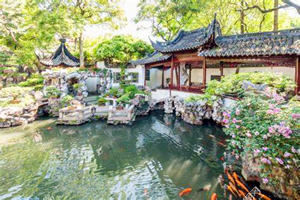 Yu Garden
Yu Garden
Yu Garden is the only classical Jiangnan garden situated in the bustling city of Shanghai. It was originally a private garden of the Ming Dynasty, built during the reigns of Emperor Jiajing and Wanli, boasting a history of over 450 years. In ancient Chinese, the words "豫"(Yu) and "愉"(Yu) share similar meanings, which conveys joy and contentment. Therefore, the owner of this garden, Pan Yunduan (潘允端), named it "Yu Garden" as a filial expression of piety towards his beloved parents, wishing for their well-being and happiness. Within the garden, there are elegant pavilions, curved corridors and charming bridges. The stones showcase unique formations, while the trees remain lush and verdant, creating a serene and beautiful scene that encapsulates the artistic style of Jiangnan garden architecture from the Ming and Qing dynasties.
Among the many highlights that await discovery are the Sansui Hall, Wan Hua Tower, Huxinting Pavilion, the Nine-turning Bridge, Yu Ling Long (Exquisite Jade Stone), and the awe-inspiring Dragon Walls. Each corner whispers a story, inviting you to explore.
Sansui Hall(三穗堂)
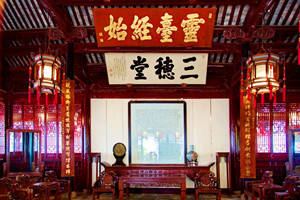 Sansui Hall
Sansui Hall
Sansui Hall derives its name from the phrase "one stalk with three ears of grain", which signifies prosperity and good fortune, as well as prayers for favorable weather and a bumper crop.With a long history, Sansui Hall has served as a venue for various occasions. In the past, it was where local officials and literati gathered to celebrate the emperor's birthday and national celebrations, wishing the emperor a long and healthy life. It was also where local officials "proclaimed imperial edicts" when there were significant events from the central government. On ordinary days, scholars would gather here to discuss and debate learning and matters. In essence, Sansui Hall seems to be a "club" for scholars.
Upon entering the hall, you can see open windows around the perimeter. At the center of the hall, a giant frame houses the "Yu Garden Record", written by the owner Pan Yunduan and inscribed by modern calligrapher Pan Boying (潘伯鹰). A vase and a bronze mirror are placed on the table in the hall, symbolizing "peace and tranquility". Under the illumination of lanterns on the beams, the entire hall exudes a sense of serenity, solemnity, and elegance.
Wan Hua Tower(万花楼)
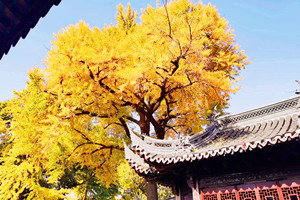 the gingko tree
the gingko tree
The Wan Hua Tower scenic area is a space gathering various architectural elements of classical Chinese gardens: pavilions, corridors, mountains, trees, and walls. After visiting the Sansui Hall scenic area, you enter the Wan Hua Tower scenic area. The Wan Hua Tower, a two-story building, boasts an exquisite design, exuding a sense of delicate elegance and nobility. Originally, this site was the location of the Hua Shen (Goddess of Flower) Tower during the Ming Dynasty. Carefully carved and engraved, the Tower features four clay sculpture windows in its four corners on the first floor, each representing a seasonal flower: plum, orchid, bamboo, and chrysanthemum, symbolizing a continuous blooming throughout the year. According to legend, the gingko tree located to the west of the Tower was planted by the owner of this garden, Pan Yunduan. Standing at a height of 21 meters, this tree has a history of over four hundred years.
Chinese Garden Landscape
Huxinting Pavilion & Nine-turning Bridge
The Huxinting Pavilion, known as the "First Teahouse in Shanghai", is situated in the center of the lotus pond in Yu Garden, with its two ends connected to the Nine-turning Bridge. Some believe that walking across this zigzag bridge is a way to traverse the twists and turns of life, ensuring good fortune and success in all endeavors thereafter.
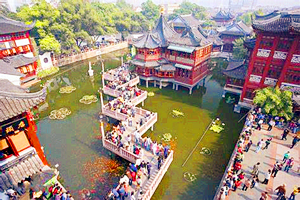 Huxinting Pavilion & Nine-turning Bridge
Huxinting Pavilion & Nine-turning Bridge
From the bridge, you can gaze up at the bustling figures within the pavilion. On rainy days, the teahouse is shrouded in a hazy mist, making the figures by the windows appear like ethereal beings. Crossing the bridge to approach the pavilion, you can see a gold-lettered plaque hanging above the entrance, with every seat taken in the teahouse. Inside this elegant and ancient building, hexagonal palace lanterns hang high, and the tea tables are neatly arranged. Redwood round tables and fan-shaped benches are set up in the hall. Looking out the window, you can admire the shimmering green waves of the lotus pond, with goldfish playing freely in the water. The soaring eaves of Sansui Hall in Yu Garden peek out from the greenery. Raising the small teacup to your lip and taking a sip, you will taste its clarity and sweetness. Drinking tea here is indeed an elegant and enjoyable experience.
Yu Ling Long (Exquisite Jade Stone) & Dragon Wall
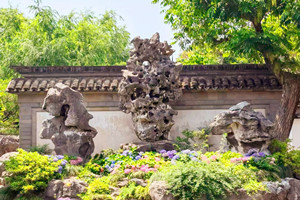 Exquisite Jade Stone
Exquisite Jade Stone
As the most valuable treasure of Yu Garden and one of the three most famous stones in the south of the Yangtze River, Yu Ling Long was said to be the limestone relic of the reign of Emperor Huizong in the Song Dynasty. It enjoys a history as long as about one thousand years. The stone has the beauty of slender shape, mysterious water holes and wrinkles all over. As the ancient saying goes, "If you place an incense burner at the bottom of the stone, you will see smoke rising from each hole".
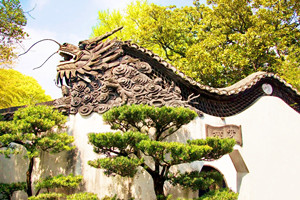 Dragon Wall
Dragon Wall
The Dragon Walls were additions during the late Qing and early Republic periods. Dragon (Loong) was originally a symbol of the Chinese emperor and was not to be used by common people. However, with the decline of the feudal dynasty, this kind of walls gradually appeared in private gardens. The Wall is crafted with tiles resembling a dragon's scales, with the entire dragon lying prone on the wall, its head raised upwards as if it is about to soar into the clouds.
Yuyuan Bazaar/ Yuyuan Market
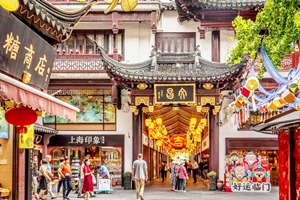 Yuyuan Bazaar/ Yuyuan Market
Yuyuan Bazaar/ Yuyuan Market
Yuyuan Bazaar lies outside the Yu Garden. Unlike Nanjing Road, it is not only a favorite spot for visitors but also a great destination for locals to immerse themselves in the bustling atmosphere of the old city. The Bazaar resembles a maze, with avenues intersecting narrow lanes. Various shops and restaurants dot the streets, just like a melting pot of diverse cultures. All the buildings in the Bazaar are replicas of Jiangnan-style architecture from the Ming and Qing dynasties, adorned with soaring eaves, painted pillars, dark tiles, and red windows. They exude a rich blend of antiquity and splendor, emitting a profound folk charm.
Here, you can find a wide array of interesting small commodities, including handicrafts, jade, jewelry, clothing, toys, and more; there's something for everyone. You can also taste delicious Shanghai-style snacks. For those who love novelty items and cuisine, this is a must-visit destination.
Travel Information
Location: 168 Fuyou Road, Huangpu District, Shanghai
Open hours: 9:00am--16:30pm
(16:00 for last entry, closed every Monday)
Recommended visiting hours: about 1 Hour
Admission: RMB 40




































